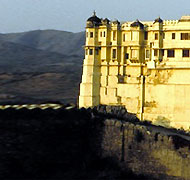 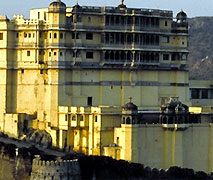 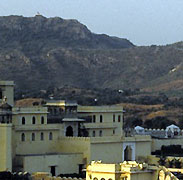  |
- || Southern Sojourn || -
Duration: 15 Nights / 16 Days
Places to Visit: Mumbai - Hyderabad - Gulbarga - Bijapur - Pattadakal - Badami - Aihole - Hampi - Hospet - Hassan - Mysore - Bangalore - Cochin - Chennai - Mahabalipuram - Kanchipuram - Chennai - Mumbai
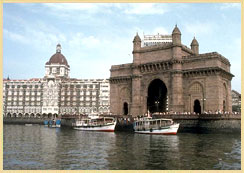 Day
1: 05 Oct Mumbai
Day
1: 05 Oct MumbaiOn arrival - met, assisted and transferred to your hotel. Rest of the day at your discretion.
Day 2: 06 Oct Mumbai
In the morning city tour. The area north of Colaba is known as Mumbai Fort, since the old British fort was once located here. There are a lot of impressive buildings from Mumbai's golden period here. St. John's church, dedicated to the soldiers, who laid down their lives in the Sindh campaign of 1838, and the first Afghan war of 1843, is also worth a visit.
Marine Drive in Mumbai: Marine Drive located in the central Mumbai, built in the 1920s and 30s on land reclaimed from the sea, is Mumbai's most famous thoroughfare. It is also referred to as the Queen's Necklace because of the dramatic line of street lamps lit up at night. Recently it has come to known as Netaji Subhashchandra Bose Road with Nariman Point on one end to Babulnath, at the foot of Walkeshwar on the other.
Gateway of India: Mumbai's principal landmark, the Gateway of India is a huge archway on the water's edge at Apollo Bunder. It is the starting point for most tourists who want to explore the city. This famous monument was built to commemorate the visit of the first ever British Monarch, King George V and Queen Mary in 1911.
Chowpatty beach situated at the end of Marine Drive has a moderate expanse of sand and is the only beach in the central part of Mumbai. One can witnesses many Hindu religious ceremonies taking place at Chowpatty like the Annual Thread-Tying Ceremony initiating young boys into the Brahmin caste, 'Nariel Purnima' towards the end of the monsoons and 'Ganesh Chaturthi' immersions.
Flora Fountain: This fountain situated in the heart of the city was erected in 1869 in honour of a British Governor of Bombay. Sir Brtle Frere. Flora Fountain marks a junction of five streets and known as the 'Picadilly Circus 'of Mumbai, which is decorated at its four corners with mythological figures, the Fountain is a structure in dull stone with a figure the Roman Goddess of flowers, at the top.
Juhu Beach: Juhu is one of the largest and frequently visited beaches of India. Located 18-km north of the city centre, it's a beckoning beach on the shores of Arabian Sea and is one of the posh localities of Mumbai where one can find the bungalows of the famous film personalities. Many shootings are held here too.
Hanging Gardens in Mumbai: Also known as Pherozeshah Mehta Gardens, the Hanging Gardens were built in 1880 and renovated in 1921. These gardens are popularly known as Hanging Gardens, because of their location on the slope of a hill. The terrace garden looks south from Malabar Hill towards Colaba, and affords a panoramic view of the city or a breathtaking sunset. It is built over three reservoirs, which store 30 million gallons of water pumped here for cleaning before being supplied to the town.
Mumbai with its lively and a confluence of varied cultural currents and cross currents have given it a unique position of the most multi-ethnic city of India. The capital city of Maharashtra State formerly known as Bombay lies in the south-western part of India and occupies a peninsular site originally composed of seven islets lying off the KONKAN COAST of western India. Oozing with the cocksure self-confidence of a maverick money maker and "Bindass" (carefree) attitude, Mumbai is also country's financial and commercial hub and has a principal port on the Arabian Sea. Yet, there's another face of Mumbai too that is of the most densely populated cities in the world. Mumbai is located on a site of ancient settlement and took its name from the local Goddess "Mumba" - a form of Parvati, the consort of Shiva, one of the principal Gods of Hinduism - whose temple once stood in what is now the south-eastern section of the Mumbai city.
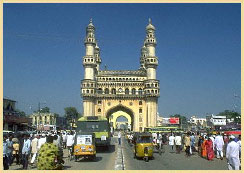 Day 3: 07 Oct Mumbai
– Hyderabad
Day 3: 07 Oct Mumbai
– Hyderabad 9W 457 0800 / 0915
You will be transferred to Hyderabad by flight. Upon arrival we visit the Charminar, the Mecca Mosque and Salar Jung Museum. After noon visit Golconda Fort uncovering the Mysteries of Golconda.
Day 4: 08 Oct Hyderabad - Gulbarga
In the morning departure to Gulbarga via Bidar. In the northern-most part of Karnataka lies Bidar-a tiny district steeped in history. The fort, the cannons, palaces in ruins, the magnificent tombs and the massive monuments, all combine to make a visit to the one-time capital of the Bahamani and Barid Shahi dynasties, truly memorable. Visit the Bidar Fort built by Ahmad Shah Bahmani between 1426 and 1432 A.D, has five Darwazas(gates) with imposing bastions lead into a little town nestling within the ramparts.
See the Rangin Mahal. The royal residence has elaborately carved wooden pillars, Persian couplets engraved in encaustic tiles and exquisite mother-of-pearl inlay work.
Near the palace are the royal kitchens and the royal baths. Further on are the Ladies Apartments with a 16 columned prayer hall built in 1423. The Solah Kamba Masjid, as it is popularly known , is the oldest Muslim building in Bidar and one of the largest in India. Not to be missed are the Gagan Mahal,the Diwan-E-Am where the fabulous turquoise throne once rested, the Takhat Mahal, the Royal Pavilion, the Hazar Kothari and the Naubat Khana.
Move on to the Bahmani Tombs at Ashtur. The interiors of the tombs are adorned with well preserved paintings that are excellent examples of medieval Muslim art. The outer walls are decorated in tile work.
The Madrasa of Mahamud Gawan is another important building in Bidar. Architecturally similar to Madrasa at Fez, this university was once a renowned center of learning ,attracting scholars from all over the Muslim world.
Then onto Gulbarga and visit the Fort here was originally built by one Raja Gulchand, a feudatory of the Orangal Kakatiyas, and was rebuilt by Allah-ud-din Bahmani with 15 majestic towers. Inside the fort is the huge wonderful mosque built by Muhammed Bahmani in 1367 and it covers 38,000 sq. feet area. The place has a huge sprawling complex housing the tomb of Bande `Nawaz, the great Sufi Saint, who came to Gulbarga in 1413. His tomb's walls have paintings and a mosque built by the Mughuls is near the tomb.
The Khandar Khan's mosque and Hirapur mosque (1585) built by Chandbibi are some other monuments here, and the tomb of Sultan Hassan and Firoze Shah are imposing structures. The state Archeology Museum here has Buddhist plaquest brought from Sannati.
Durgah Library Houses almost 10000 books on Urdu, Persian and Arabic.
Day 5: 09 Oct Gulbarga – Bijapur
Bijapur was the capital of the Adil Shah Kings who left a wealth of monuments. The most famous is the Gol Gumbaz whose dome is the second largest in the world. A whisper into the dome on one side gets magnified 12 times and on the other side of the dome is an amazing acoustical phenomenon. Other buildings to see are Ibrahim Rauza, Gagan Mahal, Bara Kaman etc.
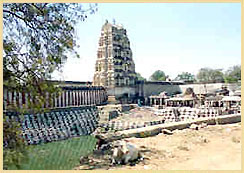 Day 6: 10 Oct Bijapur
– Pattadakal – Badami – Aihole – Hampi
Day 6: 10 Oct Bijapur
– Pattadakal – Badami – Aihole – HampiFull day excursion to Pattadakal, Badami, Aihole and continue towards Hampi for the overnight.
Pattadakal, in Karnataka, represents the high point of an eclectic art which, in the 7th and 8th centuries under the Chalukya dynasty, achieved a harmonious blend of architectural forms from northern and southern India. An impressive series of nine Hindu temples, as well as a Jain sanctuary, can be seen there. One masterpiece from the group stands out – the Temple of Virupaksha, built c. 740 by Queen Lokamahadevi to commemorate her husband's victory over the kings from the South.
Badami - the capital of the Early Chalukyas, is picturesquely situated at the mouth of a ravine between two rocky hills. Badami is famous for its four cave temples - all hewn out of sand stone on the precipice of a hill. Enter the first cave temple - past Shiva's door keepers - and there he is! The eighteen-armed Nataraja striking 81 dance poses! The largest and most ornamental is the third cave temple dedicated to Vishnu. Overlooking the cave temples is a reservoir dotted with temples dedicated to Vishnu and Shiva. Also a must are the Bhutanatha temples that lend their name to the lake beneath the cave temples.
Aihole - Famous as the "Cradle of Indian Architecture", Aihole has over a hundred temples scattered around the village.
The oldest temple here is, perhaps, the Lad Khan temple dating back to the 5th Century. The Durga (Fort) Temple is notable for its semi-circular apse, elevated plinth and the gallery that encircles the sanctum. The Hutchimalli Temple out in the village - has a sculpture of Vishnu sitting atop a large cobra.
The Revalphadi Cave - dedicated to Shiva - is remarkable for its delicate details.
Not to be missed is the Konthi Temple Complex (Kwanthi Gudi), the Uma Maheswari Temple with a beautifully carved Brahma seated on a lotus, the austere Jain Meguti Temple and the two storeyed Buddhist Temple.
Day 7: 11 Oct Hampi
Full day at your discretion or you can explore group of monuments at Hampi. HAMPI, the seat of the famed VIJAYANAGARA empire was the capital of the largest empire in post-mogul India, covering several states. The empire reigned supreme under Krishnadevaraya, the Emperor. The Vijayanagara empire stretched over at least three states - Karnataka, Maharashtra, and Andhra Pradesh. The destruction of Vijayanagar by marauding Moghul invaders was sudden, shocking and absolute. They reduced the city to ruins amid scenes of savage massacre and horrors beggaring description.
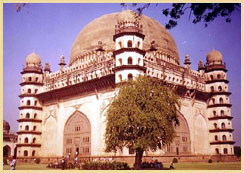 Although
in ruins today, this capital city once boasted riches known far beyond the
shores of India. The ruins of Hampi of the 14th Century lies scattered in
about 26 sq. km area, amidst giant boulders and vegetation. Protected by the
tempestuous river Tungabhadra in the north and rocky granite ridges on the
other three sides, the ruins silently narrate the story of grandeur splendor
and fabulous wealth. The splendid remains of palaces and gateways of the broken
city tells a tale of men infinite talent and power of creativity together
with his capacity for senseless destruction. Strewn over a large area (about
nine square miles) the ruins at Hampi offers to the tourist a remainder of
the greatest land in the whole world. Every rock, every path and every monument
at Hampi speak the same language; a language of glory and beaty.
Although
in ruins today, this capital city once boasted riches known far beyond the
shores of India. The ruins of Hampi of the 14th Century lies scattered in
about 26 sq. km area, amidst giant boulders and vegetation. Protected by the
tempestuous river Tungabhadra in the north and rocky granite ridges on the
other three sides, the ruins silently narrate the story of grandeur splendor
and fabulous wealth. The splendid remains of palaces and gateways of the broken
city tells a tale of men infinite talent and power of creativity together
with his capacity for senseless destruction. Strewn over a large area (about
nine square miles) the ruins at Hampi offers to the tourist a remainder of
the greatest land in the whole world. Every rock, every path and every monument
at Hampi speak the same language; a language of glory and beaty.The once-powerful Vijayanagar Empire was compared to Rome by the Portuguese traveler Paes.
Day 8: 12 Oct Hampi – Hospet – Hassan
After breakfast, we drive towards Hassan and in the afternoon visit Halebid and Belur.
Belur – the quaint hamlet - 38 kms from Hassan - is located on the banks of the river Yagachi. It was once the capital of the Hoysala Empire, today made unforgettable for its exquisite temples. The Chennakeshava Temple is one of the finest examples of Hoysala architecture. It took 103 years to complete and you can see why. The facade of the temple is filled with intricate sculptures and friezes with no portion left blank. Elephants, episodes from the epics, sensuous dancers. they are all there - awe-inspiring in their intricate workmanship. Inside are hand-lathe-turned filigreed pillars. The Veeranarayana Temple and the smaller shrines are well worth a visit.
Halebid - It is 27 kms north-west of Hassan and 17 kms east of Belur. The temples of Halebid - like those of Belur - bear mute testimony to the rich, cultural heritage of Karnataka. The Hoysaleswara Temple, dating back to the 12th century, is astounding for its wealth of sculptural details. The walls of the temple are covered with an endless variety of gods and goddesses, animals, birds and dancing girls. Yet no two facets of the temple are the same. This magnificent temple - guarded by a Nandi Bull - was never completed, despite 86 years of labor. The Jain basadis nearby are equally rich in sculptural detail. Belur and Halebid are 222 and 216 kms from Bangalore, respectively. Channarayapatna, Ramanathpur, Gorur and Manjarabad are the other places of interest around Hassan.
Day 9: 13 Oct Hassan – Mysore
After breakfast, we drive towards Mysore. On the way we visit Srirangapatnam. This island fortress, once the capital of the warrior-kings Hyder Ali and his son Tipu Sultan, has magnificent monuments that are well worth a visit.
Daria Daulat Bagh - Tipu's Summer Palace built in 1784 was his favorite retreat. Made of teak, this Indo-Saracenic structure has ornate and beautiful frescoes. It is now a museum and tells eloquently of Tipu's valour and his losing battle against the British.
Fort – It is from here that Tipu charged at the British soldiers with his legendary sword. An obelisk in the fort marks the place where he fell - betrayed by his own men. The fort holds within it, a mosque and the Ranganathaswamy Temple. Outside the fort is the Gumbaz, Tipu's tomb with splendid ebony doors inlaid with ivory.
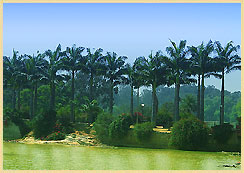 Day 10: 14 Oct Mysore
– Bangalore
Day 10: 14 Oct Mysore
– BangaloreContinue towards Bangalore. This bustling capital city of Karnataka, has a perpetual holiday atmosphere, thanks mainly to its picnic weather. Founded in 1537 by a local chieftain Kempe Gowda, Bangalore has seen much and imbibed even more. Rapid industrial growth has not taken away Bangalore's old-world charm. And a trip here can be truly delightful. Known as the Garden City and Silicon Valley of India, Bangalore offers you more than a day or two of sightseeing. There's always something going on here - music and dance concerts (both western and Indian), dramas, exhibitions, carnivals... you could go disco-hopping or pub-crawling.
See the Vidhan Soudha, Cubbon Park, Lalbagh, Bangalore Palace built in Tudor style inspired by the Windsor castle by the Wodeyar king in 1887.
Also worth a visit is the Bull Temple, built by Kempe Gowda, the founder of Bangalore. The temple is dedicated to Nandi, the sacred bull. Then visit Tipu's Palace. One of his summer retreats built in 1791, this is a two-storeyed ornate wooden structure with pillars, arches and balconies.
Day 11: 15 Oct Bangalore – Cochin
9W 523 1715 / 1815
In time transfer to the Bangalore airport for your flight to Cochin. Upon arrival in Cochin transfer to your hotel.
Day 12: 16 Oct Cochin
In the morning city tour of Cochin. A few interesting sites included in the tour are the Chinese fishing nets along the Vasco Da Gama Square, Santa Cruz Basilica, St. Francis Church, VOC Gate, Bastion Bungalow, etc. Apart from these architectural splendors, an array of restaurants serving fresh seafood is also popular among tourists. The Chinese fishing nets erected on teak wood and bamboo poles work on the principle of balance. Records say they were first set up here between AD 1350 and 1450. Vasco Da Gama Square, the narrow promenade that parallels the beach, is the best place to watch the nets being lowered and pulled out of the sea.
In the evening Kathakali dance presentation in a near by auditorium.
Overnight will be in Cochin.
Day 13: 17 Oct Cochin – Chennai
9W 3530 1205 / 1335
In time transfer to the airport for your flight to Chennai. Arrive and check in hotel.
The city stretches its 19 km length along the Coromandel coast and extends inland about 9 km at its widest. Its irregular shape covers about 172 sq km. It is a fairly low-lying strip of land, its highest point being only 60 m above sea level.
The present city of Madras is itself, however, only about 350 years old. The quest of an East India Company factor, Francis Day, for cheaper cloth and more peaceful surroundings led to the founding of Madras in 1639. Madras was Britain's first major settlement in India and it was here that many who went on to build the Empire first learnt their trade. As a consequence, the city is replete with much that is of significance in British Indian history. But the much older settlements have stories to tell too, and so the city is an amalgam of ancient and more modern history.
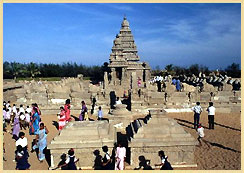 Day 14: 18 Oct Chennai
Day 14: 18 Oct Chennai
After breakfast a city tour of this traditional and cultural capital city introduces you covering Fort St. George, High Court Complex, George Town, Corporation Complex, Patheon Complex, Valluvar Kottam, Kodambakkam, St. Thomas Mount, Guindy National Park, Kalakshetra, Elliot's Beach, Theosophical Society, the Shrines of Mylapore & Triplicane Government Estate, the Marina and Anna Salai.
In the afternoon visit San Thome Cathedral, The Theosophical Society and Snake Park.
Also worth a visit is the museum. Drive through the Flower and Fruit Markets, High Court, Fort Museum and Marina Beach.
Day 15: 19 Oct Chennai – Mahabalipuram – Kanchipuram - Chennai
After breakfast proceed to Kanchipuram.
Kanchipuram is one of the oldest cities in South India, and was a city of learning for both Tamil and Sanskrit, and was believed to be visited by Hsuan Tsang. It was during the reign of Pallava dynasty, from the 4th to the 9th centuries that Kanchipuram attained its limelight. The city served as the Pallava capital, and many of the known temples were built during their reign. The Chinese martial art of Shaolin, and the Zen school of thought, both went to China and Japan from Kanchipuram. Both these great contributions were taken to the far east by the third son of a Pallava king, who would later be known as Bodhidharma.
The king of Kanchi, Pallava Mahendravarman I was a great scholar and musician, a man of great intelligence and also a great playwright. As regards learning, Kanchi stood second in glory only to Varanasi. The history of Kanchi can be traced back to several centuries before the advent of the Christian era. The place finds its name in Patanjali's Mahabhashya written in the second century BC Manimekalai, the famous Tamil classic, and Perumpanatru Padai, a great Tamil poetical work, vividly describe the city as it was at the beginning of the Christian era. Pattupattu, one of the sangam literatures records that the king Thondaiman Ilandirayan ruled this town around 2500 years ago.
From the 3rd to the 9th century Kanchi was the capital of the Pallavas who ruled over the territory extending from the river Krishna in the north to the river Kaveri in the south. The Pallavas fortified the city with ramparts, moats, etc., with wide and well laid out roads and fine temples. They were a great maritime power with contacts with far-off China, Siam, Fiji, etc., through their chief Port Mamallapuram, the modern Mahabalipuram. The Cholas ruled this town from 10th century to 13th century. Kings of Vijayanagara dynasty ruled from 14th century to 17th century. The temple tower, 192 feet height in Ekamabaranadhar temple and 100-pillar mandabam (building) in Varadaraja Perumal temple in this town are famous for the architectural techniques of Vijayanagara dynasty. Robert Clive, of the British East India Company, who played a major role in the establishment of British rule in India, is said to have presented an emerald necklace to this temple (the Clive makarakandi, still used to decorate the Lord on ceremonial occasions). Kanchi was a major seat of Tamil learning as well as an important place of pilgrimage for Buddhists, Jains and Hindus. Once the seat of learning and religious fervour started its climb down from the Mughal invasions followed by three centuries of colonial rule under the British.
Mahabalipuram, or Mamallapuram, was the chief seaport of the Pallavas who ruled over much of South India from as early as the first century B.C to the eighth century A.D., and it is now recognized as the site of some of the greatest architectural and sculptural achievements in India. Under the reign of Narasimha Varman (c. 630), this seaport began to grow as a great artistic centre. The beautiful cave temples and gigantic open air reliefs carved from blocks of granite date to the seventh century.
The descent to earth of the sacred river Ganges is the subject of the most prominent relief. The relief depicts the auspicious moment when the river flows down to the earth after the intervention of the lord Shiva. About 20 feet high and 80 feet long, it contains over a hundred figures of gods, men and beasts. A cistern was provided at the top which released water on special occasions to add a touch of reality to the tableau.
At the southern edge of Mahabalipuram is a group of five free-standing temples. Four of them were carved out of a single long granite boulder. These temples are actually detailed replicas of ancient wooden structures. These temples represent the rathas (chariots) of Arjuna, Bhima, Dharmaraja, Nakula-Sahadeva -- the five Pandava princes of the epic Mahabharata -- and their common wife, Draupadi. Work on these five temples was stopped after the death of Narasimha Varman in 668.
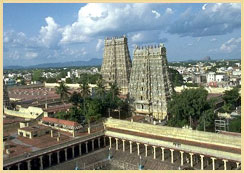 In early eighth century, work was begun on the Shore Temple at Mahabalipuram.
This temple was built to honour Lord Shiva. Unlike the temples described above,
the Shore Temple was built with granite blocks. The design of the Shore Temple
is significant because it is the earliest known example of a stone-built temple
in South India. The Shore Temple also influenced the architecture of the Cholas,
who succeeded the Pallavas as the dominant dynasty in the area now covered
by Tamil Nadu.
In early eighth century, work was begun on the Shore Temple at Mahabalipuram.
This temple was built to honour Lord Shiva. Unlike the temples described above,
the Shore Temple was built with granite blocks. The design of the Shore Temple
is significant because it is the earliest known example of a stone-built temple
in South India. The Shore Temple also influenced the architecture of the Cholas,
who succeeded the Pallavas as the dominant dynasty in the area now covered
by Tamil Nadu.Day 16: 20 Oct Chennai – Mumbai
Morning is free to unwind. Late afternoon flight to Mumbai. Upon arrival at Mumbai overnight at a nearby airport hotel.
In time proceed to the airport for departure.
"Note : Above mentioned tour programme is indicative and this programme can be cutomised / extended / shortened as per your requirement and related to places and hotels. Please allow us to fulfill your desire according to your requirements."
: Click Here For Reservation :
CONTACT US

Site Developed & Promoted by Advent InfoSoft Pvt Ltd, Creators of IndiaTravelNet & eIndiaBusiness